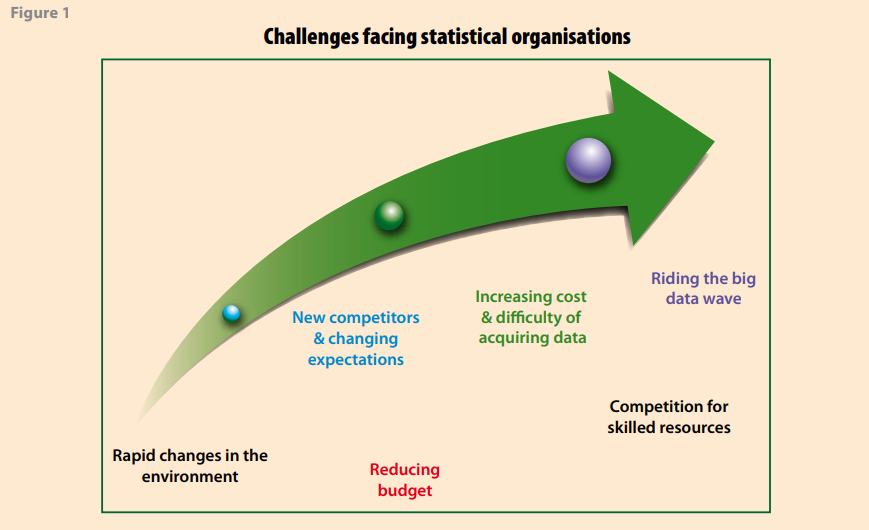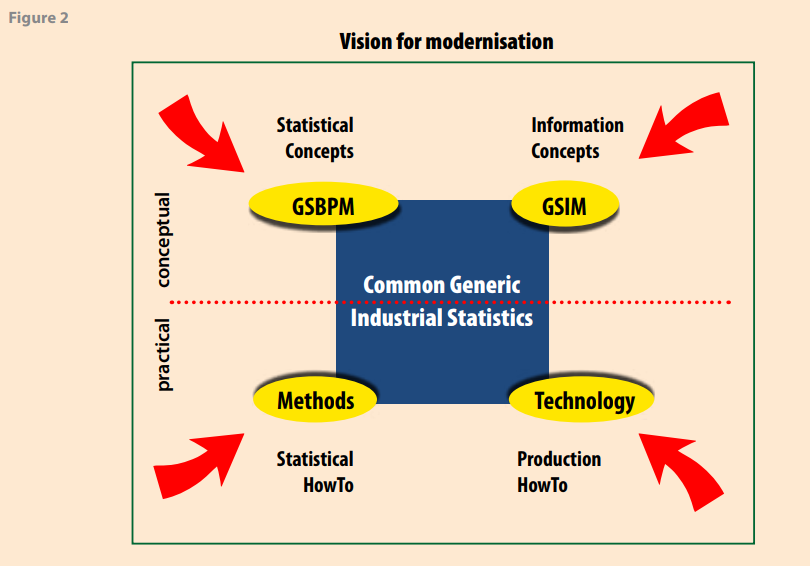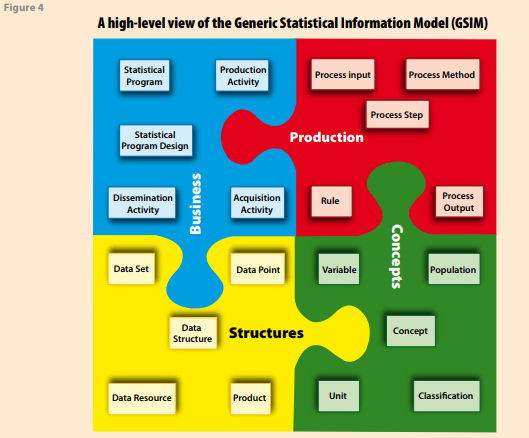Modernising the Production of Official Statistics
Edición: Vol.4 Núm.2 mayo-agosto 2013

|
El artículo ofrece un panorama de los factores para la modernización de las estadísticas oficiales, así como la respuesta de la comunidad global de generadores de estadísticas. Dicha respuesta se concretó en el recién creado Grupo de Alto Nivel para la Modernización de la Producción y Servicios de Estadísticas, el cual reúne a 10 directores de organizaciones generadoras de estadísticas nacionales e internacionales y provee de una dirección estratégica y una coordinación de las actividades en su camino hacia la modernización. Asimismo, el documento presenta un resumen de la visión de esta modernización, de los estándares en que se basa y muestra aquellos estándares que son clave en este proceso y que están desarrollándose para sustentar esta visión. |
This paper outlines the drivers for the modernisation of official statistics, and the response of the global statistical community. This response takes the form of a recently created High-Level Group for the Modernisation of Statistical Production and Services, which brings together ten heads of national and international statistical organisations, and provides strategic direction and coordination to modernisation activities. The paper summarises the vision of standards-based modernisation, and introduces the key standards that are being developed to support this vision. |
1. Introducción
We live in an age of information. The amount of information is increasing exponentially, and access to it is becoming easier. This deluge of data challenges the ability of users to build the systems and tools needed to manage it and interpret it. This situation raises a number of opportunities and challenges, which are particularly profound for producers of official statistics. From the collection or acquisition of data as raw material to the output of high quality products and services, information is the core business of national and international statistical organisations.
The changes in the relationship between people and information are leading to increased demands and higher expectations for a wider range of statistics to be made available more quickly. The challenge for statistical organisations is to be sufficiently flexible and agile to provide quality statistics quickly, to meet user needs at an acceptable cost. Cost is an important factor. At a time when it is becoming increasingly difficult and costly to collect data via surveys, governments are demanding greater efficiency. Statistical organisations have to do more with fewer resources.
Failing to address the challenges and opportunities of a world where data are available in abundance from many sources, sometimes on an almost “real time” basis, will reduce the relevance of producers of official statistics. Already there are new competitors who have the ability to produce statistics more quickly –—although not always to the same quality. Modernisation of statistical production and services is therefore essential.

2. The High-Level Group
It is clear that statistical organisations need to adapt to the changing landscape in which they operate. The challenges illustrated in Figure 1 are too big for individual statistical organisations to tackle on their own. Producers of official statistics can and should work together to address these shared challenges and make the most of new opportunities.
The High-Level Group (HLG) for the Modernisation of Statistical Production and Services was created in 2010, to coordinate the response of the official statistics community. This group consists of ten heads of national and international statistical organisations, who oversee a modernisation programme to re-invent products and processes and adapt to a changing world. The current members of the HLG are:
- Gosse van der Veen (Netherlands)-Chairman.
- Brian Pink (Australia).
- Wayne Smith (Canada).
- Eduardo Sojo Garza-Aldape (Mexico).
- Ki-Jong Woo (Republic of Korea).
- Irena Križman (Slovenia).
- Katherine Wallman (United States).
- Walter Radermacher (Eurostat).
- Martine Durand (OECD).
- Lidia Bratanova (UNECE).
3. TheVision
The HLG has produced a Strategic Vision (1) and a Strategy to Implement the Vision (2), both of which have been endorsed by the Conference of European Statisticians. The over-arching theme in these documents is to eliminate the unnecessary diversity in statistical processes and to manage the necessary diversity more strategically.
In Figure 2, the large grey square symbolises the present statistical production universe with lots of different activities and a relatively large cost. The aim of the modernisation program is to converge to the smaller blue square, increasing efficiency and value for money. The new statistical process (the blue square) can be seen as the area where the statistical production is compliant with four constraints.
 The figure is divided into two parts to reflect the conceptual and practical work needed to achieve modernisation. The HLG strategy is based on standardisation through application of common conceptual frameworks such as the Generic Statistical Business Process Model (GSBPM) and the Generic Statistical Information Model (GSIM).
The figure is divided into two parts to reflect the conceptual and practical work needed to achieve modernisation. The HLG strategy is based on standardisation through application of common conceptual frameworks such as the Generic Statistical Business Process Model (GSBPM) and the Generic Statistical Information Model (GSIM).
In order to work toward standards-based statistical production, it is first necessary to agree at the conceptual level. Thus, being able to communicate in an unambiguous manner is a prerequisite for achieving co-ordination and collaboration within and between statistical organisations.
In addition to conceptual frameworks, there is a need for agreed ways to build practical methodological and technical solutions. For example, agreement on the use of the Data Documentation.
 5. Moving to Standards-based Statistical Production
5. Moving to Standards-based Statistical Production Another HLG project, to be completed during 2013, is starting to define in practice how the technological components that support statistical production processes can be designed in the context of a “Plug and Play” architecture.
The aim is that new statistical production processes could be assembled by selecting and configuring existing modules. This will minimise the cost and risk barriers to innovation in existing statistical production processes. It will support the harnessing of new data sources to meet demands for new products in a more timely and cost-effective manner.
This approach will be a key enabler for sharing and flexible re-use of IT components within individual organisations, and across the community of producers of official statistics as a whole.
As far as possible, designers of new processes, methods, components and data repositories should already be aligning with HLG strategy and designing for sharing and reuse. This project will facilitate that requirement.
Although a fully functioning Generalised Statistical Production System is a long-term goal, it is important to note that each step along the way supports modernisation of statistical production in its own right.
6. The Benefits of Modernising the Production of Official Statistics
There are a number of benefits that will be realised when the production of official statistics is modernised:
- Improved communication about data and metadata, business processes and the methodological and technological solutions: This will support the harmonisation of processes within and between organisations. In addition there will be direct benefits such as more efficient staff training, greater staff mobility and reducing the risk of miscommunications, which lead to critical failures in business processes.
- A production environment that facilitates sharing and reuse of business processes, statistical methods and tools: This reduces unproductive duplication of investment in design, development and maintenance, and it maximises the speed of innovation across the community of producers of official statistics as a whole.
- Greater automation of statistical production processes: This reduces production costs and supports redirection of resources to activities such as analysing changing user needs and potential new data sources and innovating in regard to products and services.
- Reduction of time, cost and risk as barriers to innovation in statistical production processes: This will allow better integration of new data sources and help to meet demands for new products in a sustainable manner.
- Increased value-added from existing statistical assets through facilitating new uses: The primary example of this is being able to more readily reuse and integrate existing statistical data and metadata to deliver additional products and services.
7. Think Global, Act Local
There is a need to think globally and collaborate accordingly, maximising the ability of statistical organisations around the world to work together to address common challenges. However, progress occurs and benefits are realised when individual statistical organisations are able to implement the results locally. To do this successfully, global initiatives have to align with national priorities and strategic plans. The initiatives launched by the HLG aim to reflect the reality that organisations will continue to have business priorities and constraints which are specific to their own institutional and national contexts. Statistical organisations are invited to review their plans for redeveloping and modernising their processes and services, and to consider how they might benefit from and participate in these global initiatives.
Activities that may help organisations to make this assessment include:
- Having discussions, both at management and operational levels, to identify the drivers and options for modernising statistical production. These discussions should take into account both international directions and local circumstances.
- Asking business planning, strategy and architecture experts to review the HLG Implementation Strategy to assess the synergies with the organisation’s priorities and strategies.
- Reviewing initial HLG project outputs such as the Generic Statistical Information Model to assess in more detail the relevance to individual organisations.
8. Conclusion
Modernisation of statistical production and services is required if statistical organisations are to maintain their relevance in the “information age”. The HLG strategic plan represents an approach that maximises the ability of organisations around the world to work together in practice when addressing the challenges. The plan also reflects the reality that organisations will continue to have business priorities and constraints which are specific to their own institution and to their national context.
__________
Bibliography
High-Level Group for the Modernisation of Statistical Production and Services; “Strategic Vision of the HLG”; DE (6 March 2013, http://www1.unece. org/stat/platform/display/hlgbas/Strategic+vision+of+the+HLG).
_______ “Strategy to Implement the Vision of the HLG”; DE (6 March 2013, http://www1.unece.org/stat/platform/display/hlgbas/HLG+Strategy). UNECE; “The Generic Statistical Business Process Model”; DE (6 March 2013, www.unece.org/stats/gsbpm).
_______‘The Generic Statistical Information Model”; DE (6 March 2013, http://www1.unece.org/stat/platform/pages/viewpageaction?pageId= 59703371).
_______
1 http://www.ddialliance.org
2 http://www.sdmx.org




